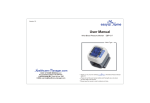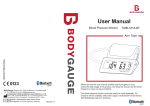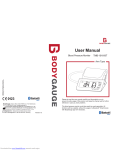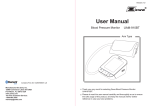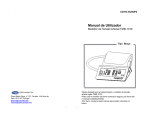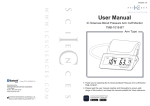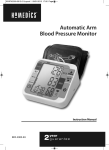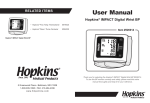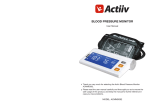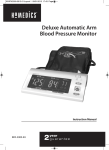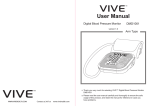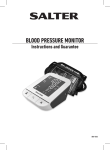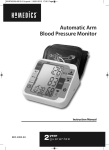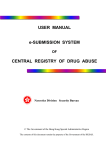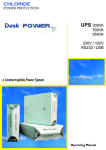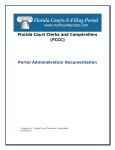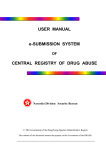Download User Manual Blood Pressure Monitor CGTEC TMB-1018
Transcript
User Manual Blood Pressure Monitor CGTEC TMB-1018 Thank you very much for selecting cgtec Blood Pressure Monitor TMB-1018. To use the monitor correctly and safely, please read the manual thoroughly. Please well keep this manual in order to reference in future. CATALOGUE INTRODUCTION ............................................................... 1 Safety information LCD display signal Monitor components BEFORE YOU START .......................................................... 4 The Choice of power supply Installing and replacing the batteries Setting Date, time and measurement unit MEASUREMENT ............................................................... 7 Tie the cuff Start a measurement THE OPERATION OF RECALLING RECORDS..................................... 9 Recall the records Delete the records INFORMATION FOR USER..................................................... 11 Tips for operation Maintenances ABOUT BLOOD PRESSURE.................................................... 13 What are systolic pressure and diastolic pressure? What is the standard blood pressure classification? Why does my blood pressure fluctuate throughout the day? Why the blood pressure I get from the hospital is different from home? If the result is the same if measuring on the right arm? TROUBLESHOOTING ......................................................... 15 SPECIFICATIONS ............................................................. 16 THE AUTHORIZED COPMONENT YOU NEED................. 17 CONTACT INFORMATION...................................................... 17 Complied European Standards list ...................................... 17 ELECTROMAGNETIC COMPATIBILITY DESCRIPTIONS................. 18 Thank you for selecting cgtec arm type blood pressure Monitor (TMB-1018). The monitor features blood pressure measurement, pulse rate measurement and auto-save the result. The design provides you with many years of reliable service. Reading taken by the TMB-1018 are equivalent to those obtained by a trained observer using the cuff and stethoscope auscultation method. This manual contains important safety and care information, and provides step by step instruction for using the product. Read the manual thoroughly before using the product. INTRODUCTION Features: 144*39mm Bright LCD display with blue backlight Maximum 60 records per user Charging measuring technology Safety information The below signs might be in the user manual, labeling or other component. They are the requirement of standard and using. Caution: Consult accompanying documents CE Mark: conforms to essential requirements of the Caution: Consult accompanying Type B applied part CE Mark: conforms to essential requirements of the Medical Device Directive 93/42/EEC. DISPOSAL: Do not dispose this product as unsorted municipal waste. Collection of such waste separately for special treatment is necessary. Manufacturer Direct current Specifies serial number Authorized Representative in the European Community CAUTION This device is intended for adult use only. This device is intended for no-invasive measuring and monitoring of arterial blood pressure. It is not intended for use on extremities other than the wrist or for functions other than obtaining a blood pressure measurement. Do not confuse self-monitoring with self-diagnosis. This unit allows you to monitor your blood pressure.Do not begin or end medical treatment based solely physician for treatment advice. If you are taking medication,consult your physician to determine the most appropriate time to measure your blood pressure. Never change a prescribed medication without consulting your physician. This unit is not suitable for continuous monitoring during medical emergencies or operations. If the cuff pressure exceeds 40 kPa (300 mmHg),the unit will automatically deflate. Should the cuff not deflate when pressures exceeds 40 kPa (300 mmHg),detach the cuff from the arm and press the button to stop inflation. To avoid measurement errors, carefully read this manual before using the product. The equipment is not AP/APG equipment and not suitable for use in the presence of a flammable anesthetic mixture with air of with oxygen or nitrous oxide. The operator shall not touch output of AC adapter and the patient simultaneously. To avoid measurement errors,Please avoid the condition of strong electromagnetic field radiated interference signal or electrical fast transient/burst signal when using the AC adaptor. The user must check that the equipment functions safely and see that it is in proper working condition before being used. The manufacturer does not require such preventive inspections by other persons INTRODUCTION LCD display signal SYMBOL DESCRIPTION Systolic blood pressure High pressure result Diastolic blood pressure Low pressure result EXPLANATION Pulse Pulse/minute Deflating CUFF air is exhausting of deflating Time (hour:minute) Currently time Memory If “M” shows, the displayed measurement values is from the memory. For instructions,refer to Page 9 mmHg Measurement Unit of the blood pressure (1mmHg=0.133kPa) kPa Measurement Unit of the blood pressure (1kPa=7.5mmHg) Low battery Batteries are low and need to be replaced Shocking remainding Shocking will result in inaccurate Average the average of blood pressure Recalling the erecords will be showed Arrhythmia Irregular heartbeat Grade the grade of the blood pressure. For instructions, refer to Page 13 Monitor components - AIR HOSE CUFF DC POWER SOCKET SET/UP BUTTON START/OFF BUTTON MEM/DOWN BUTTON LCD DISPLAY AIR CONNECTOR PLUG BATTERY COMPARTMENT DC POWER SOCKET 1.Blood Pressure Monitor (TMB-1018) 2.Cuff 3. 4*AAA alkaline batteries 4.User manual Component list of pressure measuring system 1 Cuff 2 Micro Control Unit 3 Amplifier 4 Air pipe 5 Pump 6 Valve BEFORE YOU START The Choice of Battery 1.Battery powered mode: 6VDC 4*AAA alkaline batteries 2.AC adaptor powered mode: 100-240V~, 50-60HZ,400mA (Can be supplied by AC adaptor model UE08WCP-060100SPA only!) Right picture is the hole in for power adapter. CAUTION In order to get the best effect and protect you monitor, please use the right battery and special power adapter. The installment and replacement of battery 1.Slide off the battery cover. 2.Install the batteries by matching the correct polarity, as shown. 3.Replace the cover. Replace the batteries whenever the below happen The shows The display dims The display does not light up CAUTION Remove batteries if the device is not likely to be used for some time. The old battery is harmful to the environment, so please disposal with other daily trash. Remove the old battery from the device and follow your local recycling guidelines. Setting Date, time and measurement unit It is important to set the clock before using your blood pressure monitor, so that a time stamp can be assigned to each record that is stored in the memory. (year :2000—2050,time:24 H) 1. 2. 3. 4. 5. 6. 7. When the unit is off, hold pressing “SET” for 3 seconds to enter the mode for year setting. Press the “MEM” to change the [YEAR]. When you get theright year, press“SET” to set down and turn to next step automatically. Repeat the 2 and 3 to set the [MONTH] and [DAY]. Repeat the 2 and 3 to set the [HOUR] and [SECOND]. Repeat the 2 and 3 to set the set the [UNIT]. After the unit is set, the right picture will show, then it turn off automatically. MEASUREMENT Tie the cuff 1. Tie the cuff on your upper arm, the position the tube off-center toward the inner side of arm in line with the little finger. 2. The cuff should be sung but not too tight. You should be able to insert one finger between the cuff and your arm. 3. Sit comfortably with your left arm resting on a flat surface. Resting for 5 minutes before measuring. Wait at least 3 minutes between measurements. This allows your blood circulation to recover. For a meaningful comparison, try to measure under similar conditions. For example, take daily measurements at approximately the same time, on the same arm, or as directed by a physician. Start the Measurement 1.Press the “START/STOP” to turn on the monitor, and it will finish the whole measurement automatically. LCD display Adjust the zero automatically. Inflating and measuring automatically. Display and save the results automatically. 2. Press the “START/STOP” to power off, otherwise it will turn off automatically within 1 minute. THE OPERATION OF RECALLING RECORDS Recalling the records 1.Please press the “MEM” to show the average of the record. Thesignof"AVG"willshowintherightcorner. 2.Press the “MEM” or “SET” to get the record you want. The order of the record, date, time will display alternately. It means the total of records is 8, the current is the No 2. The corresponding date is 10th November. The corresponding time is 10:38. CAUTION The most recent record (1) is shown first. Each new measurement is assigned to the first (1) record. All other records are pushed back one digit (e.g., 2 becomes 3, and so on), and the last record (60) is dropped from the list. THE OPERATION OF RECALLING RECORDS Deleting a measurement record from memory If you did not get the correct measurement, you can delete all results by following below steps. 1. Hold pressing “MEM” for 3 seconds ,the flash display will show. 2.Press “SET” to confirm deleting and the monitor will turn off automatically. 3.If you don’t want to delete the records, press “START/STOP” to escape. 4. If there is no record the right display will show. INFORMATION FOR USER Tips for measurement It can cause incorrectness if the measurement are taken in the following circumstances. Wait at least 1 hour after dinner or drinking Immediate measurement after tea, coffee, smoking Wait at least 20 minutes after taking a bath When talking or moving your fingers In a very cold environment When you want to discharge urine INFORMATION Maintenance In order to get the best performance, please follow the below instructions. Put in a dry place and avoid the sunshine Avoid touching water, clean it with a dry cloth in case. Avoid the intense shaking and collision Avoid the dusty and unstable temperature Environment Using the wet clothing to remove the dirt Avoid washing the cuff ABOUT BLOOD PRESSURE What are systolic pressure and diastolic pressure? When ventricles contract and pump blood out of the heart, blood pressure reaches its maximum value, the highest pressure in the cycle is known as systolic pressure. When the heart relaxes between heartbeats, the lowest blood pressure is diastolic pressure. Systolic blood discharging artery Diastolic blood entering vein What is the standard blood pressure classification? Below illustrates the blood pressure classification mode by World Health Organization (WHO) and International Society of Hypertension(ISH) in 1999. CAUTION Only a physician can tell you your normal blood pressure range and the point at which you are at risk. Consult your physician to obtain these values. If the measurements taken with these products fall outside the range, consult. Why my blood pressure is variable even in one day? 1. Individual blood pressure varies every in one day, it is also affected by the way you tie your cuff and the measurement position, so please take the measurement at the same condition. 2. The varies of the pressure is greater if the person take medicine. 3.Waiting at least 4-5 minutes for another measurement. Why the blood pressure I get from the hospital is different from home? The blood pressure is different even during 24 hours because of the weather, emotion, exercise etc, specially the “white coat” in hospital which makes the results are higher than the ones at home. If the result is the same if measuring on the right arm? It is ok for both arms, but there will be some different results for different person, so suggest you measure the same arm every time. TROUBLESHOOTING This section includes a list of error messages and frequently asked questions for problems you may encounter with your blood pressure monitor. If the products is not operating as you think it should, check here before arranging for servicing. PROBLEM No power Low batteries Error massage SYMPTOM Display is dim or will not light up. Show on the display E 1 shows E 2 shows E 3 shows E 10 or E 11 shows E 20 or E 21 shows Eexx,shows on the display. CHECK THIS Batteries are exhausted Batteries are inserted incorrectly. Batteries are low. The cuff is not secure The cuff is very tight The pressure of the cuff is excess. The monitor detected motion while measuring Measure incorrectly A calibration error occurred. REMEDY Replace with new batteries Insert the batteries correctly Replace with new batteries Refasten the cuff and then measure again. Refasten the cuff and then measure again. Relax for a moment and then measure again movement can affect the measurement. Relax for a moment and then measure again. Relax for a moment and then measure again. Retake the measurement. If the problem persists contact the retailer or our customer service department for further assistance. Refer to the warranty for contact information and return instructions. SPECIFICATIONS Power supply Battery powered mode: 6VDC 4*AAA alkaline batteries AC adaptor powered mode: 100-240V~, 50-60HZ, 400mA (Can be supplied by AC adaptor model UE08WCP-060100SPA only!) Display mode Digital LCD V.A.144*39mm Measurement mode Oscillographic testing mode Measurement range Pressure: 0~40kpa(0~300mmHg) pulse value:(40~199)times/minute Accuracy Pressure: within±0.4kpa(3mmHg) pulse value:±5% Normal working condition Temperature:10 ~40 Relative humidity ≤80% Storage & transportation condition Temperature:-20 ~60 Relative humidity:10%~93% Measurement perimeter of the upper arm About 22cm~42cm Weight Approx.345g (Excluding the dry cells) External dimensions Approx.180*100*42mm Attachment 4*AAA alkaline batteries user manual Mode of operation Continuous operation Degree of protection Type B applied part Protection against ingress of water IPX-0 MANUFACTURER Manufactured by: CGTEC-EUROPE, LDA Address: PRAÇA MADRE DEUS Nº 107, CANELAS, VILA NOVA DE GAIA, 4410-307 PORTUGAL Contact: [email protected] Complied European Standards list Risk management is the application of medical device EN/ISO 14971:2007 Graphical symbols for labeling medical devices EN 980: 2008 Medical equipment manufacturers to provide information EN 1041: 2008 Medical electrical equipment Part 1-1: General Requirements for Safety Collateral Standard: Safety requirements for medical electrical systems EN 60601-1:1990+A1+A2+A13 Non-invasive blood pressure Part 1: General requirements EN 1060-1:2001/A1:2002 Non-invasive blood pressure Part 3: Supplementary requirements for electromechanical blood pressure measuring system EN 1060-3:1997/A1:2005 Automatic Blood Pressure Monitor overall system Interventional accuracy of the testing process EN 1060-4: 2004 Medical electrical equipment Part 1-2: Basic safety and essential performance of the general requirements Collateral Standard: Electromagnetic compatibility requirements and tests EN 60601-1-2:2001+A1:2006 Table 1 Guidance and manufacture’s declaration – electromagnetic emissions for all EQUIPMENT and SYSTEMS Guidance and manufacture’s declaration – electromagnetic emission The TMB-1018 is intended for use in the electromagnetic environment specified below. The customer of the user of the TMB-1018 should assure that it is used in such and environment. Emission test RF emissions C ISPR 11 RF emission CISPR 11 Harmonic emissions IEC 61000-3-2 Voltage fluctuations/ flicker emissions IEC 61000-3-3 Compliance Group 1 Class B Not applicable Not applicable Electromagnetic environment – guidance The TMB-1018 uses RF energy only for its internal function. Therefore, its RF emissions are very low and are not likely to cause any interference in nearby electronic equipment. The TMB-1018 is suitable for use in all establishments other than domestic and those directly connected to the public low-voltage power supply network that supplies buildings used for domestic purposes. Table 2 Guidance and manufacture’s declaration – electromagnetic immunity – for all ME EQUIPMENT and ME SYSTEMS Guidance and manufacture’s declaration – electromagnetic immunity The TMB-1018 is intended for use in the electromagnetic environment specified below. The customer or the user of TMB-1018 should assure that it is used in such an environment. Immunity test Electrostatic discharge (ESD) IEC 61000-4-2 Electrical fast transient/burst IEC 61000-4-4 Surge IEC 61000-4-5 Voltage dips, short interruptions and voltage variations on power supply input lines IEC 61000-4-11 Power frequency (50Hz) magnetic field IEC 61000-4-8 IEC 60601 test level ±6 kV contact ±8 kV air ±2 kV for power supply lines ±1 kV line(s) to line(s) <5% UT (>95% dip in UT) for 0.5 cycle 40% UT (60% dip in UT) for 5 cycles 70% UT (30% dip in UT) for 25 cycles <5% UT (>95% dip in UT) for 5 sec 3A/m Compliance level ±6 kV contact ±8 kV air ±2kV for power supply lines ±1 kV differential mode <5% UT (>95% dip in UT) for 0.5 cycle 40% UT) (60% dip in UT) for 5 cycles 70% UT (30% dip in UT) for 25 cycles <5% UT (>95% dip in UT) for 5 sec 3A/m Electromagnetic environment – guidance Floors should be wood, concrete or ceramic tile. If floor are covered with synthetic material, the relative humidity should be at least 30%. Mains power quality should be that of a typical commercial or hospital environment. Mains power quality should be that of a typical commercial or hospital environment. Mains power quality should be that of a typical commercial or hospital environment. If the user of the TMB-1018 requires continued operation during power mains interruptions, it is recommended that the TMB-1018 be powered from an uninterruptible power supply or a battery. Power frequency magnetic fields should be at levels characteristic of a typical location in a typical commercial or hospital environment. NOTE UT is the ac. mains voltage prior to application of the test level. Table 4 Guidance and manufacture’s declaration – electromagnetic immunity – for ME EQUIPMENT and ME SYSTEMS that are not LIFE-SUPPORTING Guidance and manufacture’s declaration – electromagnetic immunity The TMB-1018 is intended for use in the electromagnetic environment specified below. The customer or the user should assure that it is used in such an environment. Immunity test Conducted RF IEC 61000-4-6 Radiated RF IEC 61000-4-3 IEC 60601 test level 3 Vrms 150 kHz to 80 MHz 3 V/m 80 MHz to 2.5 GHz Compliance level 3 Vrms 3 V/m Electromagnetic environment - Guidance Portable and mobile RF communications equipment should be used no closer to any part of the YS-6100, including cables, than the recommended separation distance calculated from the equation applicable to the frequency of the transmitter. Portable and mobile RF communications equipment should be used no closer to any part of the including cables, than the recommended separation distance calculated from the equation applicable to the frequency of the transmitter. Recommended separation distance d = 1.167 d = 1.167 80 MHz to 800 MHz d = 2.333 800 MHz to 2.5 GHz where P is the maximum output power rating of the transmitter in watts (W) according to the transmitter manufacturer and d is the recommended separation distance in meters (m). Field strengths from fixed RF transmitters, as determined by an electromagnetic site survey, a should be less than the compliance level in each frequency range. Interference may occur in the vicinity of equipment marked with the following symbol: NOTE 1 At 80 MHz and 800 MHz, the higher frequency range applies. NOTE 2 These guidelines may not apply in all situations. Electromagnetic propagation is affected by absorption and reflection from structures, objects and people. a Field strengths from fixed transmitters, such as base stations for radio (cellular/cordless) telephones and land mobile radios, amateur radio, AM and FM radio broadcast and TV broadcast cannot be predicted theoretically with accuracy. To assess the electromagnetic environment due to fixed RF transmitters, an electromagnetic site survey should be considered. If the measured field strength in the location in which the ELE007839V1 is used exceeds the applicable RF compliance level above, the ELE007839V1 should be observed to verify normal operation. If abnormal performance is observed, additional measures may be necessary, such as reorienting or relocating the ELE007839V1. b Over the frequency range 150 kHz to 80 MHz, field strengths should be less than 3 V/m. Table 6 Recommended separation distances between portable and mobile RF communications equipment and the EQUIPMENT or SYSTEM – for ME EQUIPMENT or ME SYSTEM that are not LIFE-SUPPORTING Recommended separation distances between portable and mobile RF communications equipment and the ELE007839V1 Fitness Equipment. The TMB-1018 is intended for use in an electromagnetic environment in which radiated RF disturbances are controlled. The customer or the user of the TMB-1018 can help prevent electromagnetic interference by maintaining a minimum distance between portable and mobile RF communications equipment (transmitters) and the TMB-1018 as recommended below, according to the maximum output power of the communications equipment. Rated maximum output power of transmitter W 0,01 0,1 1 10 100 Separation distance according to frequency of transmitter M 150 kHz to 80 MHz d = 1.167 0.167 0.369 1.167 3.690 11.67 80 MHz to 800 MHz d = 1.167 0.167 0.369 1.167 3.690 11.67 800 MHz to 2,5 GHz d = 2.333 0.233 0.738 2.333 7.388 23.330 For transmitters rated at a maximum output power not listed above, the recommended separation distance d in meters (m) can be estimated using the equation applicable to the frequency of the transmitter, where P is the maximum output power rating of the transmitter in watts (W) according to the transmitter manufacturer. NOTE 1 At 80 MHz and 800 MHz, the separation distance for the higher frequency range applies. NOTE 2 These guidelines may not apply in all situations. Electromagnetic propagation is affected by absorption and reflection from structures, objects and people.












